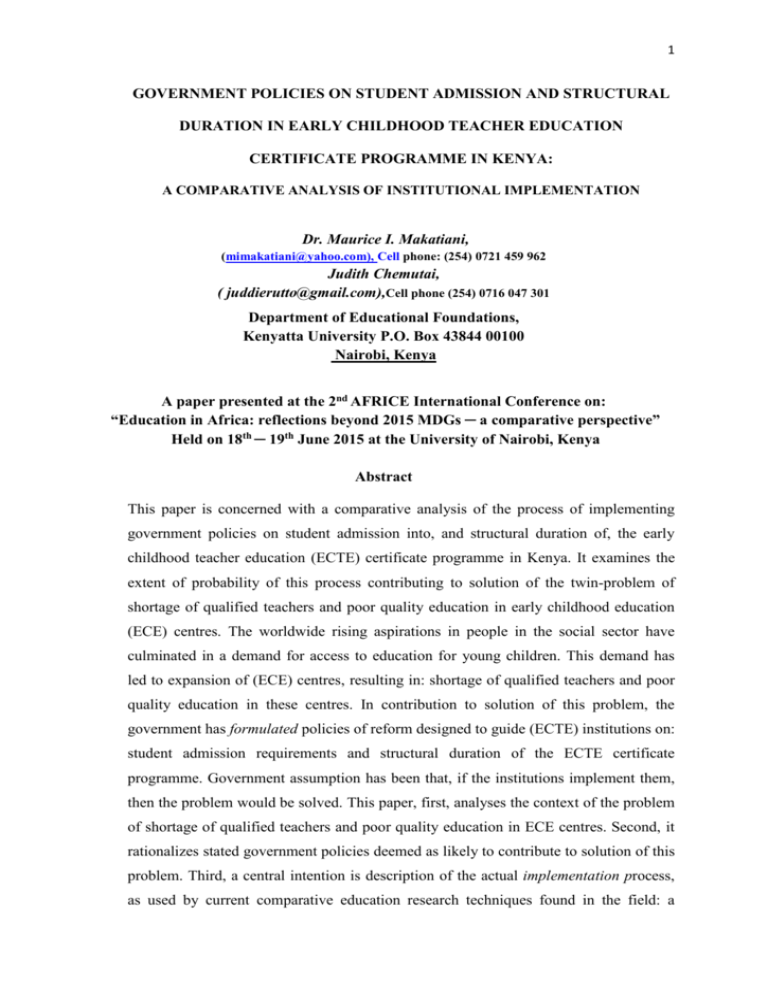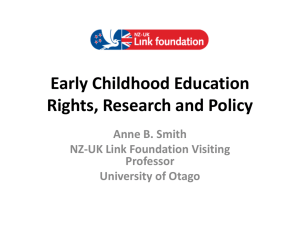makatiani maurice - University of Nairobi
advertisement

1 GOVERNMENT POLICIES ON STUDENT ADMISSION AND STRUCTURAL DURATION IN EARLY CHILDHOOD TEACHER EDUCATION CERTIFICATE PROGRAMME IN KENYA: A COMPARATIVE ANALYSIS OF INSTITUTIONAL IMPLEMENTATION Dr. Maurice I. Makatiani, (mimakatiani@yahoo.com), Cell phone: (254) 0721 459 962 Judith Chemutai, ( juddierutto@gmail.com),Cell phone (254) 0716 047 301 Department of Educational Foundations, Kenyatta University P.O. Box 43844 00100 Nairobi, Kenya A paper presented at the 2nd AFRICE International Conference on: “Education in Africa: reflections beyond 2015 MDGs ─ a comparative perspective” Held on 18th ─ 19th June 2015 at the University of Nairobi, Kenya Abstract This paper is concerned with a comparative analysis of the process of implementing government policies on student admission into, and structural duration of, the early childhood teacher education (ECTE) certificate programme in Kenya. It examines the extent of probability of this process contributing to solution of the twin-problem of shortage of qualified teachers and poor quality education in early childhood education (ECE) centres. The worldwide rising aspirations in people in the social sector have culminated in a demand for access to education for young children. This demand has led to expansion of (ECE) centres, resulting in: shortage of qualified teachers and poor quality education in these centres. In contribution to solution of this problem, the government has formulated policies of reform designed to guide (ECTE) institutions on: student admission requirements and structural duration of the ECTE certificate programme. Government assumption has been that, if the institutions implement them, then the problem would be solved. This paper, first, analyses the context of the problem of shortage of qualified teachers and poor quality education in ECE centres. Second, it rationalizes stated government policies deemed as likely to contribute to solution of this problem. Third, a central intention is description of the actual implementation process, as used by current comparative education research techniques found in the field: a 2 collective case study used for gathering data; data, which bring to surface whether, and, what gaps, similarities and differences exist in functional relationships between the stated government policies and actual practice in ECTE institutions. The paper demonstrates how conservative elements in people (adaptation from the theory of Cultural Lag analysed by William Ogburn), and variations in physical environments (adaptation from the Problem Solving Approach analysed by Brian Holmes), help to explain similarities and differences in actual institutional practice. Fourth, the paper compares relationships between the pace of increase in student enrolment in ECTE institutions and enrolment in ECE centres; between qualifications of admitted students, their duration in the ECTE programme, and the stated government policies. Finally, it suggests strategies for informed decisions and planned institutional implementation of these policies. =======================================================




